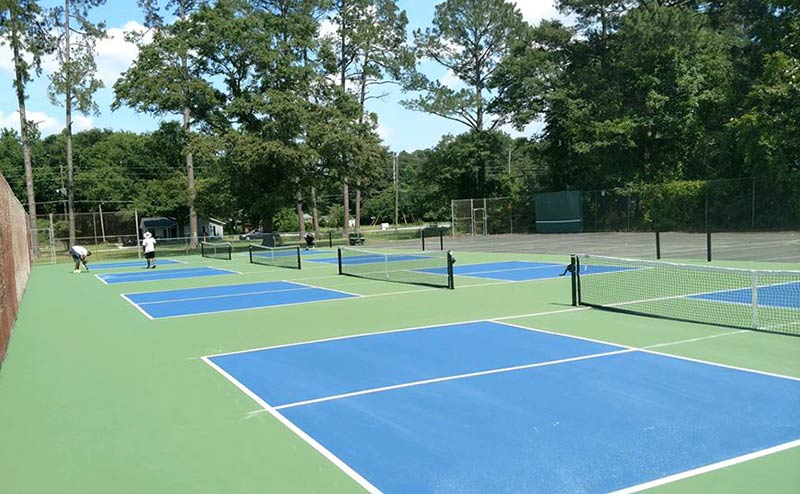Sustainable Practices in Pickleball Court Building You Must Know
As the popularity of pickleball continues to rise, so too does the requirement for lasting practices in court building. The influence of these practices expands much beyond the court itself.
Selecting Eco-Friendly Products
Choosing environmentally friendly materials is a crucial step in the building of lasting pickleball courts. The option of sustainable materials not only reduces ecological impact but also enhances the longevity and performance of the court. Key materials include recycled rubber for the surface area, which offers excellent longevity and shock absorption while diverting waste from landfills.
Additionally, utilizing in your area sourced products minimizes transport discharges and sustains regional economic climates. Pickleball court construction. Utilizing native woods for secure fencing and seating can provide a lasting aesthetic while making certain durability versus the elements.
Including permeable materials for court foundations can better contribute to sustainability by permitting all-natural water drain and minimizing runoff. These selections not only shield regional ecological communities yet additionally promote much healthier play atmospheres.
Efficient Drain Solutions
While the option of eco-friendly materials is essential, executing reliable water drainage options is similarly critical for maintaining sustainable pickleball courts. Correct drainage not only safeguards the court surface area from water damages however additionally minimizes erosion and runoff, promoting environmental integrity.
Effective drain systems can include permeable paving, which enables water to infiltrate the ground rather than pooling on the surface. This reduces the possibility of standing water, which can cause mold and mildew and various other maintenance issues. Furthermore, integrating strategically placed drainage channels and swales can route excess water far from the court area, guaranteeing a dry having fun surface area and stopping soil disintegration.
Making use of native greenery in the landscape design around the courts can additionally boost drain by absorbing excess water and lowering overflow. These plants need less watering and promote biodiversity, straightening with lasting techniques.
Additionally, it is crucial to frequently keep the drainage system to ensure its long-term efficiency. This consists of clearing up particles and surveillance for clogs. By focusing on effective drain options, pickleball court manufacturers can considerably add to the sustainability and durability of the facility, ultimately profiting both players and the environment.
Energy-Efficient Illumination Options
As the need for pickleball remains to grow, integrating energy-efficient illumination alternatives right into court design has come to be progressively vital for sustainability. Standard lights systems commonly eat too much power, adding to greater functional expenses and environmental effect. Taking on modern, energy-efficient innovations is important for both brand-new constructions and renovations.
LED (Light Emitting Diode) lighting attracts attention as a top option as a result of its durability and power cost savings (Pickleball court construction). Contrasted to conventional lighting, LEDs use approximately 75% less power and can last as much as 25 times much longer, dramatically decreasing upkeep costs. In addition, the directional nature of LED lights lessens light contamination, making certain that lighting is concentrated on the court instead of surrounding locations.

Lasting Surface Area Alternatives
Exploring sustainable surface choices for pickleball courts has actually acquired grip amongst builders and players alike. The emphasis on environmentally friendly products not just straightens with the expanding ecological awareness but also enhances the performance and toughness of the courts.
This material provides superb shock absorption, minimizing the risk of injuries for gamers while promoting sustainability. These tiles are simple to set up and change, and their flexibility allows for different court configurations.
Natural yard courts are also emerging as a sustainable option, advertising biodiversity and lowering the warm island impact. Nonetheless, they call for normal upkeep and water, which might not straighten with all sustainability goals.

Water Conservation Strategies

One more effective strategy involves the installment of rainwater harvesting systems. These systems gather and keep rainwater for usage in maintaining court surface areas and landscape design. This technique not just saves safe and clean water however additionally minimizes dependence on community resources.
Furthermore, using drought-resistant landscaping around the courts is necessary. Indigenous plants require less water and are much better adjusted to local environment problems, hence decreasing general water intake. Furthermore, using reliable watering systems, such as drip watering, guarantees that water is provided straight to plant origins, decreasing evaporation and waste.
Conclusion
Integrating lasting practices in pickleball court building and construction substantially adds to environmental preservation and source efficiency. By prioritizing these techniques, the construction of pickleball why not try this out courts can line up with more comprehensive environmental goals while advertising long life and functionality within communities.
As the popularity of pickleball continues to climb, so also does the need for sustainable methods in court building and construction.Picking environmentally friendly materials is an essential step in the construction of sustainable pickleball courts. By focusing on energy-efficient lighting options, pickleball court builders can contribute to an extra sustainable future while meeting the needs of players and stakeholders alike.Incorporating lasting surface area choices not only boosts the performance of pickleball courts but also paves the means for applying reliable water preservation strategies.Integrating sustainable techniques in pickleball court building and construction substantially contributes to environmental conservation and source effectiveness.
Comments on “Custom-made Pickleball Court Construction for Residential and Commercial Spaces”